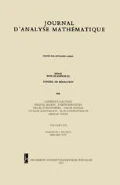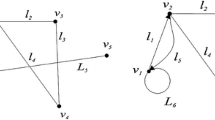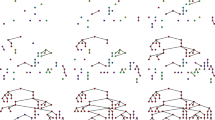Abstract
LetG be an infinite connected graph with vertex setV. Ascenery onG is a map ξ :V → 0, 1 (equivalently, an assignment of zeroes and ones to the vertices ofG). LetS n n≥0 be a simple random walk onG, starting at some distinguished vertex v0. Now let ξ and η be twoknown sceneries and assume that we observe one of the two sequences ξ(S n) n≥0 or {η(S n)} n≥0 but we do not know which of the two sequences is observed. Can we decide, with a zero probability of error, which of the two sequences is observed? We show that ifG = Z orG = Z2, then the answer is “yes” for each fixed ξ and “almost all” η. We also give some examples of graphsG for which almost all pairs (ξ, η) are not distinguishable, and discuss some variants of this problem.
Similar content being viewed by others
References
K. Burdzy,Some path properties of iterated Brownian motion, inSeminar on Stochastic Processes (E. Çinlar and M. J. Sharpe, eds.), BirkhÄuser, Boston, 1993, pp. 67–87.
J. T. Cox and R. Durrett,Oriented percolation in dimension d ≥4: bounds and asymptotic formulas, Math. Proc. Camb. Phil. Soc.93 (1983), 151–162.
D. A. Darling and M. Kac,On occupation times for Markoff processes, Trans. Amer. Math. Soc.84 (1957), 444–458.
W. Th. F. den Hollander,Mixing properties for random walk in random scenery, Ann. Probab.16 (1988), 1788–1802.
J. L. Doob,Stochastic Processes, Wiley, New York, 1953.
R. Durrett,Probability: Theory and Examples, Wadsworth & Brooks/Cole, Pacific Grove, 1991.
M. Harris and M. Keane, in preparation, 1995.
C. D. Howard,Orthogonality of measures induced by random walks with scenery, Combinatorics, Probability and Computing, to appear.
CD. Howard,Detecting defects in periodic scenery by random walks on ℤ Random Structures Algorithms8 (1996), 59–74.
C. D. Howard,The orthogonality of measures induced by random walk with scenery, Ph.D. Thesis, Courant Inst. Math. Sciences, New York, 1995.
K. ItÔ and H. P. McKean, Jr.,Potentials and the random walk, Ill. J. Math.4 (1960), 119–132.
J-P. Kahane, J. Peyrière, Z-Y. Wen and L-M. Wu,Moyennes uniformes et moyennes suivant une marche aléatoire, Prob. Theor. Rel. Fields79 (1988), 625–628.
M. Keane and W. Th. F. den Hollander,Ergodic properties of color records, Physica138A (1986), 183–193.
J. Kerstan and K. Matthes,Gleichverteilungseigenschaften von Faltungspotenzen auf lokalkompakten abelschen Gruppen, Wiss. Z Friedrich Schiller Univ. Jena, Math.-Natur. Reihe14 (5) (1965), 457–462.
H. Kesten,Hitting probabilities of random walks on ℤ d, Stoch. Proc. Appl.25 (1987), 165–184.
H. Kesten and F. Spitzer,A limit theorem related to a new class of self similar processes, Z. Wahrsch. verw. Geb.50 (1979), 5–25.
T. Lindvall,Lectures on the Coupling Method, Wiley, New York, 1992.
A. Rényi,Probability Theory, North-Holland, Amsterdam, 1970.
P. Révész,Random Walk in Random and Non-Random Environments, World Scientific, Singapore, 1990.
F. Spitzer,Principles of Random Walk, D. van Nostrand, Princeton, 1964.
F. Spitzer,Discussion on subadditive ergodic theory by J. F. C. Kingman, Ann. Probab.6 (1973), 883–909.
Author information
Authors and Affiliations
Additional information
The work of I.B. was supported by the US. Army Research Office through the Mathematical Sciences Institute of Cornell University. The work of H.K. was supported by the NSF through a grant to Cornell University.
Rights and permissions
About this article
Cite this article
Benjamini, I., Kesten, H. Distinguishing sceneries by observing the scenery along a random walk path. J. Anal. Math. 69, 97–135 (1996). https://doi.org/10.1007/BF02787104
Received:
Revised:
Issue Date:
DOI: https://doi.org/10.1007/BF02787104




